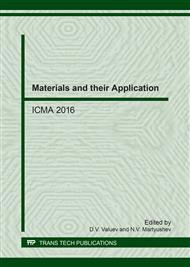p.147
p.153
p.161
p.166
p.171
p.179
p.183
p.187
p.191
Processing of Industrial Metallurgical Wastes as the Basis of Manufacturing Technology Welding Fluxes and Additives NIM1
Abstract:
Presented are the results of the use of metallurgical wastes as constituents of welding fluxes. On the basis of fine particle gas purification in aluminum production, a carbon fluoride additive (FD-UFS) has been designed for welding fluxes which allows for manufacturing of steel constructions of northern execution with improved mechanical properties of welded joints. It is shown that the introduction of FD-UFS to fluxes AN-348, AN-60 and AN-67 increases the range of the required mechanical properties. Composition and manufacturing technology has been developed for a new welding flux with application of slag from silicomanganese production. Fractional composition of the flux has been selected. A comparative assessment of the mechanical properties of the developed flux with widely used flux AN-348 (GOST 9087-81) showed that the mechanical properties of the new flux are much greater. It has been determined that the introduction of flux additive FD-UFS in the amount of 2-8 % significantly increases the value of toughness KCV at a temperature of minus 20 °C.
Info:
Periodical:
Pages:
191-196
Citation:
Online since:
June 2017
Authors:
Price:
Сopyright:
© 2017 Trans Tech Publications Ltd. All Rights Reserved
Share:
Citation:


